Header logo
header top contact widget
LANAP
Reshaping Gum Tissues To Protect Oral Health & Enhance Smiling Appearance
Posted on Mar 21, 2024 by William J. Claiborne, DDS MS
When people think about the appearance of their smiles, it’s typically the teeth that are the focus. Everyone wants a smile that enhances appearance, instills self-confidence and gets compliments. Yet, the appearance of a smile involves more than just teeth. The “frame” of gum tissues that arch the teeth most visible in a smile have a lot to do with how a smile looks.
As a periodontal specialist in Asheville, NC, part of my specialty involves the treatment of all stages of periodontal (gum) disease, the placement of dental implants, and the contouring of gum tissues. Gum contouring is generally done for esthetic reasons but may also be advised for oral wellness.
Gums most often pull away from the base of teeth (or “recede”), exposing darker areas of the tooth. This darker area is part of the tooth’s root and highly vulnerable to damage. Recession also causes teeth to look longer and expose darker tooth root areas of the tooth. Being sensitive to hot or cold – causing a sudden jolt of pain – is often the final warning sign that the gums are not protecting tender root segments of the tooth.
Gum recession is commonly due to:
• Gum disease, which destroys gums tissues, causing them to loosen their firm grip around the base of teeth. This enables oral bacteria to penetrate beneath the gum line, reaching vulnerable bone and tissues.
• Over-vigorous toothbrushing can wear away precious gum tissues that surround the base of teeth. When using a back-&-forth scrubbing motion, or a hard toothbrush, gum tissues can be scrubbed off. Too, using abrasive substances to brush (such as baking soda) not only wear down gum tissues, they wear away tooth enamel.
• The aging process lessens hydration in the body. Because the gum tissues are moist layers that require continual hydration (supported by saliva), oral dryness can cause the gums to draw up as they become drier. Unfortunately, this creates more challenges in maintaining healthy teeth.
While gum recession is an oral health concern, it is a cosmetic issue as well. For an attractive smile, teeth should be arched by a balanced level and shape of gum tissues. When there is too much gum tissue showing above teeth or varying heights of gums arching teeth, the height and symmetry of gum tissues can be corrected by a periodontist.
For example, in a gummy smile, too much of the gum line is visible. This makes teeth look short and draws the eye to the gums rather than the teeth. Gum tissues should complement teeth with a balanced line of gum tissues. While a gummy smile is not generally problematic for one’s oral health, many people find it makes them “hold back” on smiling fully.
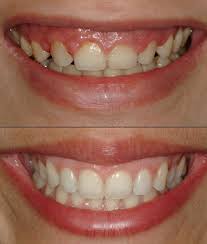
Before & After Of A Gummy Smile
The procedure to correct a gummy smile is a gingival lift, also known as a gum lift or gum contouring. This in-office procedure is performed to reduce and reshape highly visible gums.
In our Western NC periodontal dental office, we use a dental laser to perform a gingival lift. Our dental laser gives a precision line while only removing specific areas of the gums, leaving all surrounding tissue unharmed. This allows us to reshape the gums to create better balance in the smile.
A laser gingival lift also offers patients a more comfortable experience since it causes very little pain and therefore requires only topical anesthesia. In addition, laser treatments result in almost no bleeding and tissues tend to heal more quickly than after traditional surgery.
We also perform gum grafting that recovers areas where gum recession has occurred. This helps to protect the tooth roots and improves the appearance of the smile.
In gum grafting, we normally take a small area of tissue from the roof of the mouth and place it in the area of recession. When there is not sufficient tissue available, a graft may be from a donor source. The graft is attached to the natural gum tissue and gently sutured into the position where it corrects a smile’s appearance and reduces further recession and the potential for gum disease.
Several teeth may be involved in gum grafting when used to even out the gum line or reduce the risk of gum and bone collapse after a tooth has been lost. In these cases, cosmetic gum surgery is beneficial in reshaping excess gum and bone tissue. It also reduces sensitivity from exposed roots to hot or cold foods.
As a periodontist, I most commonly see gums that cover too much of the teeth as being due to genetics. When gums fail to cover sufficiently over the base of teeth, it’s typically the cause of recession, which can occur from several reasons (as listed prior). Regardless of why it has occurred, our goal is to provide the patient with the most healthy and esthetic outcome in a procedure that is comfortable, successful, and requires minimal healing time.
In our Asheville periodontal dental office, we offer some of the most advanced dental technology available. In addition to amazing imaging, such as Cone Beam 3D imaging, we provide Laser-Assisted New Attachment Procedure (or LANAP). This is a cutting-edge protocol to more efficiently and effectively treat periodontitis (advanced gum disease) with the PerioLase® MVP-7™ laser. Treatment is minimally invasive and helps to minimize both discomfort and recovery time. It has also been found to stimulate bone regrowth in damaged areas.
Additionally, our office offers both oral and I.V. sedation (“twilight sleep”) for complete relaxation during treatment. Sedation is administered safely by a doctor of anesthesia to provide optimal safety and comfort.
If finances have kept you from seeking out the care you need or the beautiful smile you desire, feel free to contact our friendly staff and arrange a consultation appointment. During this time, we can discuss the best options for you, cost estimates, and predicted treatment time.
We can also review several payment plans that make treatment affordable through extended, interest-free payment periods with no down payment required. These often help our patients enjoy their confident, new smiles while making easy monthly payments that are budget friendly.
Call 828-274-9440 to schedule.
As You Age, Avoid A ‘Melting’ Face With Dental Implants
Posted on Feb 26, 2024 by William J. Claiborne, DDS MS
It seems the older one gets, the more conscious he or she is to the need for good health practices. While periodic exams and check-ups are part of this, eating healthy and getting ample exercise are practical ways to support a healthy body.
The same principles apply to oral health. While annual physical exams are needed, regular check ups and dental hygiene cleanings are as well. Through decades of research, “bad” bacteria in the mouth can lead to inflammatory reactions that can offset or worsen a number of health problems far beyond the mouth.
For now, let’s focus on your gum health and the presence of teeth. While natural teeth are the ideal structure for biting, chewing and speaking, the rigors of age – the natural wear and tear – can take its toll on teeth. Decay, gum disease, accidents and certain illnesses can lead to losing a tooth or teeth over the span of a lifetime.
There are several ways to replace a missing tooth (or teeth). A crown-&-bridge is a longstanding method to replace one or several teeth in one area. Or, a partial denture can replace a “scattering” of teeth in the same arch. However, the downside of these oral prosthetics is what’s beneath the gum line.
Your natural teeth are supported by your upper and lower jaw bone, known respectfully as the maxilla and mandible. With these strong, study bones, tooth roots are held securely. Thus, biting and chewing occurs comfortably.
The jaw bones are actually kept healthy by the presence of tooth roots. These roots provide stimulation to the bone as well as nourishment that feeds through the tooth’s interior.
When a tooth is removed, so is the stimulation and nourishment to that area of the jaw bone. Without it, the bone begins to shrink. As it declines in height, the adjacent teeth are more vulnerable to loss. Statistics show that teeth adjacent to areas where natural teeth are missing will be the most likely to be lost next.
This has a domino effect. Partials can replace the presence of teeth above the gum line, but there is nothing to benefit the jaw bones below. Thus, tooth loss continues and can go from a few missing teeth to losing all teeth (being “edentulous”).
According to the Center for Disease Control & Prevention (CDC), 69 percent of adults between the ages of 35 – 44 have lost at least one permanent tooth. By age 50, Americans are missing an average of 12 teeth. For adults between the ages of 65 – 74, 26 percent are missing all of their natural teeth. That’s over one-fourth of the adult population over age 65.
Although dentures and partials mimic the presence of teeth, the jaw bones below are shrinking away, and at a rather rapid pace. The pressure of wearing a denture or partial actually speeds this process up, known as “resorption.”
As these bones decline in mass, deep wrinkles form around the mouth. The corners of the mouth turn downward. The chin takes on a more pointed form and the mouth sinks into the face. The nose seems to get closer to the chin as the jaw bones thin. Jowls form as facial muscles detach from shrinking bone structure.
Changes in facial appearance also take place when bone structures shrink. For example, as the jaw bone thins, deep wrinkles form around the mouth. The corners of the mouth will start to turn down, even in a smile. Jowls form on each side of the face as facial muscles detach from the shrinking bone structure.
As the jaw bone declines further, the chin becomes more pointed and the nose seems to get closer to it. This leads to a collapsed mouth that is known as a “granny look.” This look ages the appearance of an individual far beyond their actual years.
Not to be overlooked is the ability to comfortably bite and chew food. This is essential for the digestive process, since the first stage of digestion begins in the mouth. When adults struggle to eat with a denture or partial, the efficiency of this initial stage of digestion is compromised.
It’s not unusual for adults who have “rocky” or “slippery” dentures to opt for soft foods that dissolve easily in the mouth. These are often carb heavy and lack the nutritional value of a diet that combines healthy proteins, fruits and vegetables.
However, missing teeth or dentures that move when eating can cause other detrimental problems. When people sense their dentures may cause embarrassment when eating, speaking or laughing with others, social involvement can take a hit. According to a 2012 statement by the World Health Organization:
“Oral health is essential to general health and quality of life. It is a state of being free from mouth and facial pain, oral and throat cancer, oral infection and sores, periodontal (gum) disease, tooth decay, tooth loss, and other diseases and disorders that limit an individual’s capacity in biting, chewing, smiling, speaking, and psycho-social well-being.”
As an Asheville periodontist, my dental specialty includes the diagnosis and placement of dental implants. Dental implants are the closest thing to natural teeth.
Dental implants were designed to recreate the presence of natural teeth both above and below the gum line. Because teeth attached to the implants are supported by the jaw bone, the study foundation restores the ability to bite and chew without movement or fear of embarrassing slips.
For patients who are missing a great deal of bone, we offer bone rebuilding that does not require a bone graft. We also perform sinus lifts (when the upper jaw has declined to a significant level) to restore sufficient bone distance between vital structures.
For many of our dental implant patients, their lives become more active with the restored confidence. They become more socially involved, have more self-confidence and higher self-esteem. And the advantages of dental implants over other tooth replacement options are numerous.
• Dental implants are designed to last your lifetime. They do not decay, need root canals or compromise neighboring teeth or bone structure.
• Because dental implants are positioned in the jaw, they recreate stimulation to the bone. This helps to preserve the bone’s mass, halting the pace of jaw bone shrinkage (known as resorption).
• Resorption is what causes changes in one’s facial appearance, aging one’s appearance far older than their actual age.
• Dental implants do not move or slip when eating, speaking or laughing. A denture is designed to fit the contours of one’s gum ridge; contours that exist at the time the denture is made. However, as resorption reduces bone height, the ridge that holds the denture flattens out over time. This is why a denture becomes ‘wobbly’ or ‘slippery.’
• Dental implant treatment is largely determined by the number of implants placed. In most cases, one implant can support more than one tooth. A full arch (all upper or lower) of teeth are typically supported by several strategically-placed implants.
• Unlike a crown-&-bridge, dental implants so not need the support of adjacent teeth. Therefore, it is not necessary to have teeth shaved down for crowning simply to serve as supports for a bridge.
In our Asheville periodontal dental office, we have highly-advanced technology that aids in the diagnosis and placement process of dental implants. These features help to enhance patient comfort, shorten treatment time, and provide optimal results. Advanced technology includes: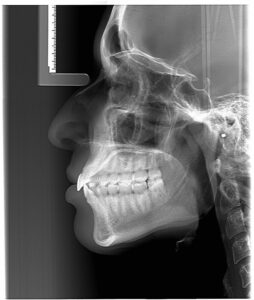
– Computerized Dental Implant Placement – an advanced system for pre-surgical positioning of dental implants using a 3D model of the patient’s jaw. Once the implant type is selected, a template is developed for optimal treatment success.
– Cone Beam Imaging – is ideal for diagnoses and treatment planning through images that provide a clear view of the upper and lower jaw (including nerve canals), with rotations that show sagittal, axial, and coronal planes in a process that is quick, painless and at minimal radiation levels.
– Dental Laser – This small, hand-held device is a tremendous asset when it comes to both the health and appearance of gum tissues. Not only does the laser eliminate or greatly minimize bleeding during procedures, it reduces numbing requirements, removes bacteria and easily uncovers gum tissue where dental implants have been placed. Additionally, laser dentistry can beautifully re-contour or repair gum tissue with a precision line.
As a periodontal specialist serving Western NC, I take great pride in the diagnosis and placement of dental implants with each selected based upon the patient’s individual needs and goals. We provide oral or I.V. sedation to ensure a comfortable experience and a friendly, respectful environment.
To schedule an examination appointment or to begin with a consultation, call 828-274-9440. A referral is not always necessary.
Dental Implants – Advantages of Specialized Skills, Advanced Technology, Optimal Comfort
Posted on Jan 10, 2024 by William J. Claiborne, DDS MS
It wasn’t that long ago when shopping for Christmas presents was quite the time-consuming ordeal. Today, we do searches for gift ideas online, check price comparisons, and have the items show up on our doorstep within a day or so.
Advancements through computerized technology have things running more efficiently and, in many cases, culminate into superior outcomes. This is true in dentistry, especially for those who opt for dental implants to replace missing teeth.
There are many reasons for people to choose dental implants, including:
– Designed to last a lifetime
– Look, feel and function like natural teeth
– Won’t decay or need repairs
– Restore chewing and biting comfort and stability
– Enhance overall health and confidence
– Halt the process of facial bone loss
Occasionally, dental implants are occasionally offered by general dentists. As a periodontist, however, I am referred most of our dental implant patients by other dentists and dental specialists. This is because a periodontist has advanced education and skills in the diagnosis and treatment of all areas of the tissues in the mouth (including the reshaping of gum tissues).
Periodontists are also specialists when it comes to the diagnosis and placement of dental implants. They are trained to understand the intricate concepts involved in selecting the proper type of implant based on each individual. These skills include the understanding of precision placements of implants at proper depths and angles. Additionally, periodontists are able to optimize your comfort and treatment outcome.
Still, another reason we are referred patients for dental implants because we can offer patients a wider variety of choices when it comes to implant systems.
There are many types of dental implants. Various systems are designed to support one replacement tooth (the “restoration”), a bridge of two or more teeth, or a full denture supported by several strategically-placed implants. Understanding the unique advantages of all systems enables us to choose the best type for the patient’s individual needs and goals.
For example, the All On Four dental implant system is designed to support non-removable teeth on just 4 implants (per arch). With its specially-designed implanted portions, these longer implants can fully distribute biting and chewing forces.
All-On-4 is an ideal choice for people who have lost bone mass due to lengthy periods of tooth loss. Because “All On 4” implants can be placed in minimal bone, many patients are able to avoid the need for bone rebuilding procedures prior to traditional implant placement.
In the placement, a periodontist is also the best “go-to” in dental implant skills. Here’s why…
For a dental implant to serve as a lasting tooth replacement system, it must be positioned in the jaw bone to specific depths and angles. An implant that is wrongly positioned can function less efficiently and lead to the need for removal.
For example, a periodontist can incorporate bone rebuilding procedures into treatment to a proper depth for patients missing a great deal of bone mass (typically due to missing natural teeth for many years). This can help to restore bone that has occurred in the mandible (lower jaw) or maxilla (upper jaw), which may also require a sinus lift.
Another example is a patient who has lost teeth due to periodontal (gum) disease. Because a periodontist combines advanced skills in treating gum disease as well as in dental implants, these patients have an added advantage when it comes to treatment success.
When it comes to the best way to pinpoint and tackle specific issues with our health, it makes sense to see a doctor who has received specialized training in that area. This helps to take the guesswork out of diagnosis and enhances the potential for a successful outcome in an efficient process.
A periodontist also has a reputation for being able to optimize patient comfort. Because a periodontal specialist is uniquely skilled in the care of gum tissues, he or she can provide a conservative approach to the placement process. Through respectful treatment of oral tissues (in both placement and exposure for restorations), less disruption to the gums allows for faster healing and higher comfort levels.
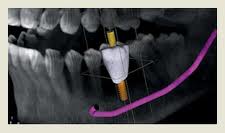 In our Western NC periodontal dental office, we incorporate our care with the advantages of some of the most advanced technology in dentistry; many options which are not readily available in other dental offices in our region. These computerized images offer advantages to patients in helping to minimize treatment needs.
In our Western NC periodontal dental office, we incorporate our care with the advantages of some of the most advanced technology in dentistry; many options which are not readily available in other dental offices in our region. These computerized images offer advantages to patients in helping to minimize treatment needs.
These include:
- LANAP (Laser-Assisted New Attachment Procedure) with PerioLase MVP 7 – an advanced protocol that efficiently and effectively treats advanced gum disease with the added advantages of a dental laser. This offers a non-surgical alternative for patients with moderate to severe periodontal disease and has even been found to stimulate bone regrowth in damaged areas.
- Cone Beam Imaging – is ideal for diagnoses and treatment planning through images that provide a clear view of the upper and lower jaw (including nerve canals), with rotations that show sagittal, axial, and coronal planes in a process that is quick, painless and at minimal radiation levels.
- CareStream Cone Beam Computer Tomography Imaging – is enhanced tomography that works with 3D imaging for exceptional detail and range.
- CS 3600 Intraoral Scanner – quickly and comfortably captures digital impressions to create precision models or appliances accurately and easily (crowns, inlays, onlays, bridges, orthodontic appliances, aligners, custom abutments) without the need for bulky, goopy trays.
- Computerized Dental Implant Placement – an advanced system for pre-surgical positioning of dental implants using a 3D model of the patient’s jaw. Once the implant type is selected, a template is developed for optimal treatment success.
For optimal comfort, we offer several sedation options, including oral and IV sedation. Oral sedation is a pill that helps patients relax. It also has an amnesiac effect, leaving most with little or no memory of treatment afterward. I.V. sedation (also known as “twilight sleep”) places the patient in a deeper sleep state and erases memory of the procedure. It is administered by a doctor of anesthesiology for optimal comfort and safety.
In our Western NC periodontal dental office, anesthesia is overseen by a Medical Doctor (MD) who is a board certified Anesthesiologist. With both sedation options, patients are closely monitored with advanced safety equipment throughout treatment.
Our goal is to help people move forward with treatment affordably for enhanced appearance, self-confidence and sense of security.
For those who have bypassed dental implants because of cost, our payment plans are often able to help patients enjoy the benefits of their dental implants without straining their budget. Most of these payment plans require no down payment, are interest-free, and have no prepayment penalty.
If you’ve considered dental implants in the past but have held back because of obstacles that may actually be overcome, begin by calling our Asheville periodontal dental office and speaking to our friendly staff at: 828-274-9440. Many dental implant patients find they were able to achieve the healthy smile they desired once they consulted with us and learned the options based upon their individual needs.
Achieve Smile Goals With A Periodontist
Posted on Dec 11, 2023 by William J. Claiborne, DDS MS
If you’re like me, I’m usually looking at the end of each year feeling like there are several things I wanted to accomplish for the year, but kept putting them off until I ran out of time.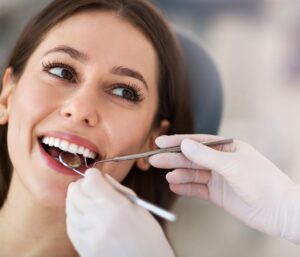
For some people, their oral health and appearance goals are on this list, with some who keep moving the goals to the next year and the next. These goals may include:
• Improving the appearance of a smile
• Having a “cleaner” mouth with fresh breath, etc.
• Replacing missing teeth
• Getting past fear or anxiety of dental visits
If you have one of these on your list, you may be surprised that a periodontal specialist can play a major role in helping you achieve your goals. And, because of the advanced skill level of a periodontist, your comfort, time in treatment and overall results can make the process easier for you.
Many general dentists and other dental specialists refer their patients to a for their specific skills. A periodontist is a dental specialist who is the expert in caring for the gum tissues in your mouth and in the placement of dental implants.
The majority of patients arrive because of periodontal (gum) disease. Common symptoms are red, swollen and tender gums. It often causes gum that bleed easily (often noticed when brushing teeth) and persistent bad breath.
Gum disease (sometimes referred to as ‘perio’ disease) only worsens without treatment. It is the leading cause of adult tooth loss. Additionally, it has been linked to the development or worsening of a long list of serious health problems elsewhere in the body.
Because the inflammatory bacteria disease can enter the bloodstream through diseased gums, their presence can activate conditions that are seemingly unrelated to oral health. Yet, the connection is severe. These health problems include stroke, heart attack, Alzheimer’s disease, dementia, preterm babies, some cancers, arthritis, diabetes, and erectile dysfunction (ED).
In our Asheville periodontal dental office, we are able to treat all stages of gum disease to restore your oral health and minimize the risk of tooth loss. For those who have developed gum disease because they’ve been afraid of dental visits, we offer oral and IV sedation (“twilight sleep”).
Sedation is administered safely by a doctor in anesthesia who uses advanced safety equipment. Our priority is always patient comfort with their safety equally so.
Too, our advanced technology is able to minimize treatment time with amazing results. For example, LANAP (Laser-Assisted New Attachment Procedure) combined with PERIOLASE MVP-7 is designed to efficiently and effectively treat periodontitis (advanced gum disease) with the advantages of a dental laser. This offers non-surgical treatment for patients with moderate to severe periodontal disease. LANAP treatment minimizes discomfort and has a quick recovery time. It has also been found to stimulate bone regrowth in damaged areas.
When tooth loss has occurred (whether from gum disease, an accident, or due to genetics), our NW NC dental specialty office also works with a number of dentists in the diagnosis and placement of dental implants.
With over 40 different implant systems, the one suited best for you depends on factors that an experienced dentist must take into consideration. For example, the number of implants you need and how much jaw bone mass exists.
For individuals who have lost a great deal of bone, specific implant types may be recommended. Some, like the “All On 4” implant system, uses specially designed implants which are placed at specific angles.
Bone loss can also be overcome by incorporating a bone rebuilding process into treatment. This is done prior to implant placement and does not require a bone graft. In many cases, we can apply a bone rebuilding material that restores ample bone mass.
The same is true when the sinus cavity will be too close to the proximity. This can be remedied through a “sinus lift.” We provide complete services of these procedures as well as dental implant placement – all performed with advanced skills and technology, such as our Cone Beam 3D imaging.
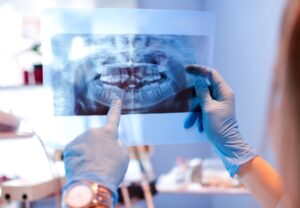 These images are ideal in diagnosis and treatment planning by giving a clear view of the mandible and maxilla (upper and lower jaw). Cone beam radiographs provide images in sagittal, axial, and coronal planes. This makes it possible to locate and trace the mandibular nerve canal for pre-surgical planning for an ideal implant position. Patients are exposed to only minute levels of radiation through a process that is fast and comfortable.
These images are ideal in diagnosis and treatment planning by giving a clear view of the mandible and maxilla (upper and lower jaw). Cone beam radiographs provide images in sagittal, axial, and coronal planes. This makes it possible to locate and trace the mandibular nerve canal for pre-surgical planning for an ideal implant position. Patients are exposed to only minute levels of radiation through a process that is fast and comfortable.
When the enhanced appearance of a smile is being sought, a periodontist also plays a part in helping to create a balanced smile line. In the procedure known as “crown lengthening,” the arch of gum tissues over teeth visible in a smile can be repositioned. This is done in a procedure known as a gingivectomy.
A gingivectomy is also performed to repair a “gummy smile.” This is when too much gum tissue shows above the teeth most visible in a smile. While the condition is not detrimental to oral health, some individuals seek to have it corrected by a periodontist.
Get the coming year started with your smile goals achieved! Call our Asheville periodontal dental office to schedule a consultation. Our friendly staff can help you arrange this private time together by calling 828-274-9440.
Recent Posts
Categories
Archives
- September 2024
- August 2024
- July 2024
- June 2024
- May 2024
- April 2024
- March 2024
- February 2024
- January 2024
- December 2023
- November 2023
- October 2023
- September 2023
- August 2023
- July 2023
- June 2023
- May 2023
- April 2023
- March 2023
- February 2023
- January 2023
- December 2022
- November 2022
- October 2022
- September 2022
- August 2022
- July 2022
- June 2022
- May 2022
- April 2022
- March 2022
- February 2022
- January 2022
- December 2021
- November 2021
- October 2021
- September 2021
- August 2021
- July 2021
- June 2021
- May 2021
- April 2021
- March 2021
- February 2021
- January 2021
- December 2020
- November 2020
- October 2020
- September 2020
- August 2020
- July 2020
- June 2020
- May 2020
- April 2020
- March 2020
- February 2020
- January 2020
- December 2019
- November 2019
- October 2019
- September 2019
- August 2019
- July 2019
- June 2019
- May 2019
- April 2019
- March 2019
- February 2019
- January 2019
- December 2018
- November 2018
- October 2018
- September 2018
- August 2018
- July 2018
- June 2018
- May 2018
- April 2018
- March 2018
- February 2018
- January 2018
- December 2017
- November 2017
- October 2017
- September 2017
- August 2017
- July 2017
- June 2017
- May 2017
- April 2017
- March 2017
- February 2017
- January 2017
- December 2016
- November 2016
- October 2016
- September 2016
- August 2016
- July 2016
- June 2016
- May 2016
- April 2016
- March 2016
- February 2016
- January 2016
- December 2015
- November 2015
- October 2015
- September 2015
- August 2015
- July 2015
- June 2015
- May 2015
- April 2015
- March 2015
- February 2015
- January 2015
- December 2014
- November 2014
- October 2014
- September 2014
- August 2014
- July 2014
- June 2014
- May 2014
- April 2014
- March 2014
- February 2014
- January 2014
- December 2013
- November 2013
- October 2013
- September 2013
- August 2013
- July 2013
- June 2013
- May 2013
- April 2013
- March 2013
- February 2013
- January 2013
- December 2012
- November 2012
- October 2012
- September 2012
- August 2012
- July 2012
- June 2012


